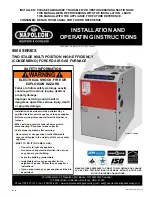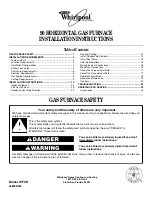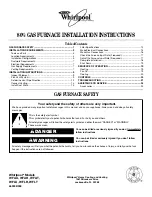
FIRE HAZARD AND UNIT RELIABILITY
Failure to follow this warning could result in property
damage, personal injury or death.
When operating furnace in heating mode, static pressure and
temperature rise (supply-air temperature minus return-air
temperature) must be within those limits specified on rating
label.
Step 5—Limit Control Check
After furnace has been in operation for at least 15 minutes, restrict
return-air supply by blocking filters or closing return registers and
allow furnace to shut down on high limit. The burner should shut
off, and main blower should continue to run.
Step 6—For Year-Round Air Conditioning
This furnace is designed for use in conjunction with cooling
equipment to provide year-round air conditioning. The blower has
been sized for both heating and cooling, however, fan motor
setting may need to be changed to obtain necessary cooling
airflow.
CARE AND MAINTENANCE
ELECTRICAL SHOCK, FIRE OR EXPLOSION
HAZARD
Failure to follow this warning could result in possible damage
to this equipment, serious personal injury, or death.
The ability to properly perform maintenance on this equip-
ment requires certain expertise, mechanical skills, tools, and
equipment. If you do not possess these, do not attempt to
perform any maintenance on this equipment other than those
procedures recommended in the User’s Manual.
ELECTRICAL SHOCK HAZARD
Failure to comply with this warning could cause electrical
shock resulting in personal injury or death.
Before performing any service functions, unless operations
specifically require power to be on, make sure all utilities are
turned off upstream of appliance.
Step 1—General
In order to keep this furnace in good operating condition and to
maintain its warranty, the furnace MUST be serviced on an annual
basis. This servicing includes a nozzle change, a burner inspection,
a visual check of tube passages through flue outlet and cleanout
ports, and a visual inspection of combustion chamber when burner
is removed.
Depending on above inspection, service could also include a
cleaning and vacuuming of heat exchanger tubes and possibly the
heat exchanger drum section.
Removal of any heat exchanger components which are sealed by
gaskets requires replacement of gasket.
CARBON MONOXIDE POISONING HAZARD
Failure to replace any heat exchanger gaskets with new
gaskets when any heat exchanger plates or covers are re-
moved could lead to heat exchanger leakage, sooting, and/or
a hazardous condition capable of causing personal injury or
death.
This furnace should never be operated without an air filter.
Disposable filters should be replaced at least once a year. If
equipped to provide cooling, filters should be replaced a minimum
of twice a year. Permanent filters should be cleaned at least twice
a year.
ALWAYS KEEP MAIN OIL VALVE TURNED OFF IF
BURNER IS SHUT DOWN FOR AN EXTENDED PERIOD OF
TIME.
Step 2—Oil Burner
For optimum performance, oil burner nozzle should be replaced
once a year. Contact your service technician if you are unsure of
this procedure.
The procedure for nozzle installation and/or replacement is out-
lined in oil burner instruction manual which came with furnace.
After replacement of nozzle, burner should be adjusted in accor-
dance with Combustion Check section of this instruction.
Step 3—Heat Exchanger and Flue Pipe
Ordinarily, it is not necessary to clean heat exchanger or flue pipe
every year, but it is necessary to have your service technician
check unit before each heating season to determine whether
cleaning or replacement of parts is required.
If cleaning is necessary, the following steps should be performed:
1. Turn off all oil and electrical supplies upstream of furnace.
BURN HAZARD
Failure to follow this caution may result in minor personal
injury.
If furnace has been in operation, some surfaces may be hot.
Allow time for unit to cool down.
2. Disconnect flue pipe.
3. Remove flue collar panel located in rear part of furnace.
4. Remove flue silencer from secondary heat exchanger.
5. Disconnect oil line and remove oil burner from furnace.
6. Clean primary and secondary heat exchangers with a stiff
brush and vacuum cleaner.
7. Before reassembly, heat exchanger/combustion chamber
should be inspected to determine if replacement is required.
8. After cleaning, replace flue silencer, flue collar, and oil
burner.
9. Readjust burner for proper operation.
Step 4—Blower Removal
To remove blower from furnace:
1. Turn off all oil and electrical supplies upstream of furnace.
2. Remove blower access door.
3. Remove air filters.
4. Remove blower retaining wing nuts.
Table 12c—58VLR120 Size Dip Switch CFM
Adjustments in All Modes
SW2-ADJUST
DIP SWITCH POSITION
HEATING CFM %
INCREASE OR
DECREASE
COOLING CFM %
INCREASE OR
DECREASE
1
2
OFF
OFF
0
0
ON
OFF
+ 13
+ 10
OFF
ON
- 15
- 10
ON
ON
N/A
0
14






































